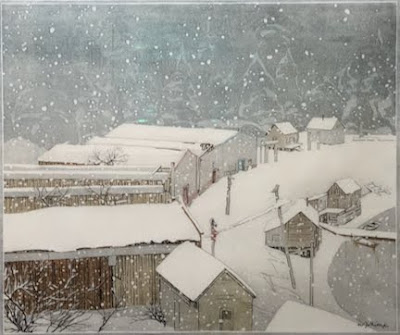Mary Pratt (1935-2018) and Christopher Pratt (b. 1935) married young, in 1957, having met in art school. Together they raised four children. This book examines the challenges typically faced by women of the era, who were expected to put aside their professional ambitions so as to better support their husband's career and manage the household. Mary continued to make art even while her children were young, and in later years her career can be seen as eclipsing that of her husband.
Both are important figures in the Atlantic Canada art world, producing prolifically as well as serving on many committees and councils. Mary held a seat on the Canada Council for six years, and served as a regent for Mount Alison University for eight. She played an important role in the establishment of The Rooms, Newfoundland's premiere art gallery. Christopher accepted the role of curator of the then newly-opened Memorial University Art Gallery, and sat on the board of the Canada Council for the Arts from 1975-1981. For a time, he also taught at Memorial University.
Bishop-Gwyn's unauthorized biography is thoroughly researched and rich with detail. Much of her book deals with the complications of married life. Christopher, for example, entered into an affair with one of his young models. When he gave Mary some of his discarded slides featuring the model, she used them to inspire her own portraits of the young woman. The general opinion was that Mary's paintings of the young woman were superior, more full of life and emotion than Chrisopher's studies of the same subject. In many respects the two artists were rivals as well as intimate partners.
Some critics of Mary Pratt's work have found her subject matter mundane and commonplace. Others revel in her celebration of the everyday. Often her subjects suggest "containment", and it is interesting to survey her many paintings with this theme in mind.
As a young man, Pratt worked summers as a surveyor, and this no doubt contributed to his artistic vision. He favours a flat, full-frontal approach, like that of filmmaker Wes Anderson. Critics of Christopher Pratt's work regret that he so often directed his energies to the medium of silkscreen instead of his oil painting, but it could be that the affordability of his limited edition prints helped to popularize his paintings and raise their value. He continues to sell his prints and paintings through the Mira Godard Gallery.
Carol Bishop-Gwyn has written a fascinating book from a feminist perspective, documenting the personal and professional lives of two important Canadian artists.
 |
| Night on the Veranda, Christopher Pratt silkscreen, 1986 |
Both are important figures in the Atlantic Canada art world, producing prolifically as well as serving on many committees and councils. Mary held a seat on the Canada Council for six years, and served as a regent for Mount Alison University for eight. She played an important role in the establishment of The Rooms, Newfoundland's premiere art gallery. Christopher accepted the role of curator of the then newly-opened Memorial University Art Gallery, and sat on the board of the Canada Council for the Arts from 1975-1981. For a time, he also taught at Memorial University.
Bishop-Gwyn's unauthorized biography is thoroughly researched and rich with detail. Much of her book deals with the complications of married life. Christopher, for example, entered into an affair with one of his young models. When he gave Mary some of his discarded slides featuring the model, she used them to inspire her own portraits of the young woman. The general opinion was that Mary's paintings of the young woman were superior, more full of life and emotion than Chrisopher's studies of the same subject. In many respects the two artists were rivals as well as intimate partners.
 |
| Eggs in Egg Crate, Mary Pratt oil, 1973 |
Some critics of Mary Pratt's work have found her subject matter mundane and commonplace. Others revel in her celebration of the everyday. Often her subjects suggest "containment", and it is interesting to survey her many paintings with this theme in mind.
 |
| Jelly Shelf, Mary Pratt oil, 1999 |
As a young man, Pratt worked summers as a surveyor, and this no doubt contributed to his artistic vision. He favours a flat, full-frontal approach, like that of filmmaker Wes Anderson. Critics of Christopher Pratt's work regret that he so often directed his energies to the medium of silkscreen instead of his oil painting, but it could be that the affordability of his limited edition prints helped to popularize his paintings and raise their value. He continues to sell his prints and paintings through the Mira Godard Gallery.
Carol Bishop-Gwyn has written a fascinating book from a feminist perspective, documenting the personal and professional lives of two important Canadian artists.





















